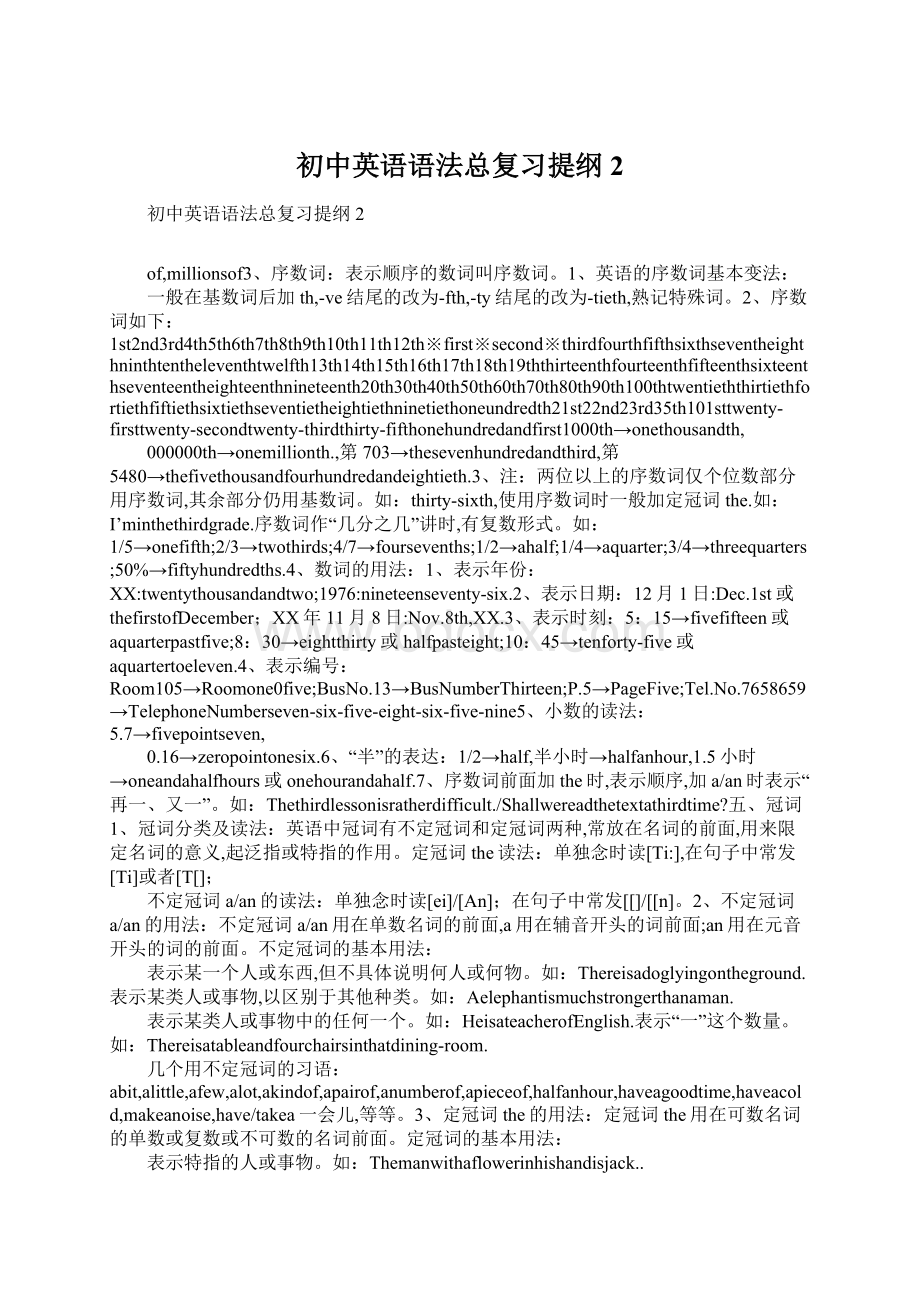初中英语语法总复习提纲2.docx
《初中英语语法总复习提纲2.docx》由会员分享,可在线阅读,更多相关《初中英语语法总复习提纲2.docx(7页珍藏版)》请在冰豆网上搜索。

初中英语语法总复习提纲2
初中英语语法总复习提纲2
of,millionsof3、序数词:
表示顺序的数词叫序数词。
1、英语的序数词基本变法:
一般在基数词后加th,-ve结尾的改为-fth,-ty结尾的改为-tieth,熟记特殊词。
2、序数词如下:
1st2nd3rd4th5th6th7th8th9th10th11th12th※first※second※thirdfourthfifthsixthseventheighthninthtentheleventhtwelfth13th14th15th16th17th18th19ththirteenthfourteenthfifteenthsixteenthseventeentheighteenthnineteenth20th30th40th50th60th70th80th90th100thtwentieththirtiethfortiethfiftiethsixtiethseventietheightiethninetiethoneundredth21st22nd23rd35th101sttwenty-firsttwenty-secondtwenty-thirdthirty-fifthonehundredandfirst1000th→onethousandth,
000000th→onemillionth.,第703→thesevenhundredandthird,第5480→thefivethousandfourhundredandeightieth.3、注:
两位以上的序数词仅个位数部分用序数词,其余部分仍用基数词。
如:
thirty-sixth,使用序数词时一般加定冠词the.如:
I’minthethirdgrade.序数词作“几分之几”讲时,有复数形式。
如:
1/5→onefifth;2/3→twothirds;4/7→foursevenths;1/2→ahalf;1/4→aquarter;3/4→threequarters;50%→fiftyhundredths.4、数词的用法:
1、表示年份:
XX:
twentythousandandtwo;1976:
nineteenseventy-six.2、表示日期:
12月1日:
Dec.1st或thefirstofDecember;XX年11月8日:
Nov.8th,XX.3、表示时刻:
5:
15→fivefifteen或aquarterpastfive;8:
30→eightthirty或halfpasteight;10:
45→tenforty-five或aquartertoeleven.4、表示编号:
Room105→Roomone0five;BusNo.13→BusNumberThirteen;P.5→PageFive;Tel.No.7658659→TelephoneNumberseven-six-five-eight-six-five-nine5、小数的读法:
5.7→fivepointseven,
0.16→zeropointonesix.6、“半”的表达:
1/2→half,半小时→halfanhour,1.5小时→oneandahalfhours或onehourandahalf.7、序数词前面加the时,表示顺序,加a/an时表示“再一、又一”。
如:
Thethirdlessonisratherdifficult./Shallwereadthetextathirdtime?
五、冠词1、冠词分类及读法:
英语中冠词有不定冠词和定冠词两种,常放在名词的前面,用来限定名词的意义,起泛指或特指的作用。
定冠词the读法:
单独念时读[Ti:
],在句子中常发[Ti]或者[T[];
不定冠词a/an的读法:
单独念时读[ei]/[An];在句子中常发[[]/[[n]。
2、不定冠词a/an的用法:
不定冠词a/an用在单数名词的前面,a用在辅音开头的词前面;an用在元音开头的词的前面。
不定冠词的基本用法:
表示某一个人或东西,但不具体说明何人或何物。
如:
Thereisadoglyingontheground.表示某类人或事物,以区别于其他种类。
如:
Aelephantismuchstrongerthanaman.
表示某类人或事物中的任何一个。
如:
HeisateacherofEnglish.表示“一”这个数量。
如:
Thereisatableandfourchairsinthatdining-room.
几个用不定冠词的习语:
abit,alittle,afew,alot,akindof,apairof,anumberof,apieceof,halfanhour,haveagoodtime,haveacold,makeanoise,have/takea一会儿,等等。
3、定冠词the的用法:
定冠词the用在可数名词的单数或复数或不可数的名词前面。
定冠词的基本用法:
表示特指的人或事物。
如:
Themanwithaflowerinhishandisjack..
指谈话双方都熟悉的人或事物。
如:
Lookattheblackboard,Lily.
复述前面提到过的人或事物。
如:
Thereisamanunderthetree.ThemaniscalledRobert.
表示世界上独一无二的事物。
如:
Theearthturnsaroundthesun.
用在表示方位的名词前面。
如:
TherewillbestrongwindtothesouthoftheyangtzeRiver.
在序数词和形容词最高级的前面。
如:
whoisthefirstonetogo?
/ofallthestars,thesunisthenearesttotheearth.
常用在乐器名称的前面。
如:
Hebegantoplaytheviolinattheageof5.
用在江河、海洋、山脉等名称的前面。
如:
IhaveneverbeentotheHimalayamountains.
用在含有普通名词的专有名词的前面。
如:
HeisfromtheUnitedStatesofAmerica.用在姓氏之前表示一家人。
如:
TheGreensaregoingtomountEmeinextmonth.same之前一般用the。
如:
LucyandLilylookthesame.几个用定冠词的习语:
atthesametime,makethebed,intheend,allthetime,bytheway,ontheway等等。
4、一些不用冠词的情况:
专有名词和一些不可数名词时前面通常不用。
如:
chinaisaverylargecountry./manneedsairandwater.名词前已有指示、物主或不定代词作定语时不用。
如:
mypenismuchmoreexpensivethanyours.
周名,月名或季节名前一般不用。
如:
Hewasbornonmonday,February18,1995./Theyusuallyplanttreesonthehillsinspring.复数名词表示人或事物的类别时不用。
如:
menareclevererthanmonkeys.
三餐饭前不用。
如:
wehavebreakfastathomeandlunchatschool.
节、假日前一般不用。
如:
onchildren’sDaytheboysoftengetpresentsfromtheirparents.
球类名词前不用。
如:
ThechildrenplayfootballonSaturdayafternoons.
城市的重要/主要建筑物名称前不用。
如:
TheyarenowatPeople’scinema.
一些习惯用语中不用。
如:
⑴at/to/from/outof/after/forschool;⑵in/to/for/afterclass;⑶in/to/outof/intobed;⑷after/at/from/outof/towork;
⑸at/tosea;⑹in/from/down/totown;⑺at/fromhome;⑻at/for/tobreakfast/lunch/supper;⑼atnight/noon/midnight;⑽onfoot;⑾gotoschool/bed;⑿ontopof;⒀infrontof;⒁onshow/display/duty/watch;⒂in/outofhospital;⒃atall;⒄on/intime;⒅atfirst/last/once;⒆inchinese/English,etc.;⒇takecareof六、形容词、副词:
1、形容词:
用来说明或修饰名词、代词的词称为形容词。
1、形容词的句法作用:
作句子中名词的定语、句子的表语以及宾语补足语。
2、形容词在句子中的位置:
⑴作定语时放在名词的前面,且音节少的词放在音节多的词之前。
如:
abigyellowwoodenwheel⑵作表语时放在连系动词之后。
如:
Thepricesoundsreasonable.⑶作宾语补足语时放在宾语之后。
如:
wemusttryourbesttokeepourenvironmentclean.⑷后置的情况:
①修饰复合不定代词时放在代词之后。
如:
Somethingserioushashappenedtohim.②与表示“长、宽、高、重、老、远离”的词连用时形容词后置。
如:
He’s1.8metrestall.Themoonisabout380,000kilometresawayfromtheearth.3、有关形容词的用法辨析:
⑴whole与all:
记住两个词序:
①thewhole+名词;②allthe+名词。
如:
Hewasbusythewholemorning./Hecanrememberallthewordshelearns.⑵tall与high,short与low:
指人的个子时用tall与short;指其他事物时一般用high与low。
如:
He’sverytall/short./Talltreesarestandingonbothsidesofthatavenue./Afewpeopleliveonhighmountains.⑶real与true:
real一般指东西的真假,译为“真的”;而true则指事情或消息的可靠性,译为“真实的”。
如:
Thisisarealdiamondandit’sveryexpensive./--Isthattrue?
—yes.Ihearditwithmyownears.⑷interested与interesting的区别:
interesting指人或东西“有趣的”,作定语或表语,而interested则表示人对别的事物“感兴趣的”,只能作表语。
如:
Themanisveryinterestingandallthechildrenlikehim./Thisbookisinterestingandyoucanreallyenjoyyourself./Iaminterestedinscience.⑸such用法:
such+a+名词。
如:
Ihaveneverseensuchafoolishboy./Hehadsuchaterribleaccidentthathecouldneverforgetit.⑹good与well:
表示“好”时,作定语或表语用good,作状语用well;表示“好”时用well.如:
Doingsportsisgoodforus./Studywellandmakeprogresseveryday./--Howareyou?
—Iamverywell.⑺nice与fine:
的区别:
nice表示令人愉快的,可以指东西、人物外表等;fine一般指身体或天气好。
如:
Let’sgoandsharethenicecake./Sheisanicegirl./whatafineday!
/He’sfinerecently.⑻toomuch与muchtoo:
toomuch表示“太多的”,修饰事物数量;muchtoo表示“太过,过分”,修饰形容词或副词。
如:
IamfullbecauseIhavehadtoomuchrice./Thatcoatismuchtoodear.⑼quick、fast与soon:
quick与fast基本同义,quick往往指反应速度快,fast往往指运动速度快,而soon则表示时间上很快即将发生。
如:
Afteraquickbreakfast,hehurriedtoschoolleavinghisbagathome./Atrainismuchfasterthanabus./Hisfatherwillbebacktochinaverysoon.⑽lonely与alone:
lonely是表示心理活动的形容词,意思是:
“孤独的,寂寞的”,作定语或表语;alone的意思是:
“独自的,单独的”,指无人陪伴,仅作表语,。
如:
Helivesalonebuthedoesn’tfeellonely./Heisalonelyperson.youcannoteasilygetonwellwithhim.⑾other与else的区别:
两个词都可以作形容词,但是用法不同,other放在名词前;else修饰不定代词、疑问词、little、much,后置,另外,orelse表示“否则”,是连词。
如:
Theotherstudentsareontheplayground./whoelsecanworkoutthismathsproblem?
/Thisisnobodyelse’smoney.It’smine./Doyouhaveanythingelsetosayforyourself?
specialattentiontoclothes./Thesearespecialchairsforsmallchildren.⒀gone、lost、missing的区别:
gone表示“丢了,没了”,含一去不复返的意思,也可以表示“死了”,作表语或宾补,不可以作定语;lost表示“丢失”,含难以找回的意思,可作定语、表语或宾补;missing表示“失踪了,不见了”,强调某人物不在原处,可作定语、表语或宾补。
如:
myfeverisgone,butIstillhaveacough./Theparentsfoundthelostchildatlast./mydictionaryismissing.who’stakenitaway?
/Formoredetailedinformationofthemissinggirls,pleasevisitourwebsite.⒁living、alive、live、lively的区别:
四个词都于动词live“生活、居住”。
living读[‘liviN]有三个意思:
①“活着的、现存的”,作表语或定语,②“一模一样的、逼真的”,③相当于lively,意思是“强烈的、活泼的”;live读[laiv],指东西“活的”,可以替换为living;alive读[[‘laiv]作表语,指人“活着的”,如果作定语,则放在名词的后面;lively读[‘laivli]有三个意思:
①有生气的、活泼的、快活的,②鲜艳的,③生动的、真实的。
例如:
Alivinglanguageshouldbelearnedorally./wehavealivinghopethatyouwillsucceed./Isshestillalive?
/Theyarethehappiestchildrenalive./Thisisalivefish./Alivewireisdangerous./Sheisaslivelyasakitten./Hegavealivelydescriptionofthefootballmatch.⒂sick与ill区别:
sick和ill都表示“生病的”,但是,sick可以做定语、表语,而ill只能做表语。
如:
Hehasbeenill/sickforalongtimeandheisveryweaknow./Vetshelptreatsickpetsandmostofthepets’ownerslikethem.⒃thepoor/therich等用法:
“the+形容词”这一结构可以表示一类人物,复数含义。
如:
wemusttryourbesttohelpthepoor./Therichneverknowhowthepoorareliving.2、副词:
用来说明事情发生的时间、地点、原因、方式等含义或说明其它形容词或副词程度的词叫做副词。
1、副词的分类:
时间副词频度副词地点/方位副词程度副词方式副词疑问/连接副词其他副词today,tomorrow,once,here,there,very,too,well,how,too,also,yesterday,now,twice,home,below,enough,hard,where,nor,so,then,early,late,always,anywhere,rather,quite,alone,when,as,on,off,once,soon,just,usually,above,outside,how,so,fast,why,either,tonight,long,often,in,inside,out,much,just,together,whetheryes,no,already,yet,before,sometimes,back,up,down,nearly,onlysuddenly,however,etc.not,neitherago,later,eversincenever,away,off,far,almost,hardly,-ly结尾关系副词maybe,after,whenever,near,nearby,aslongas等,的副词where,perhaps,first,someday,ever,wherevereven,all, why,howcertainly,sometime,last, everywhere,alittle,abit when, 2、副词在句子中的位置以及作用:
⑴作状语:
①时间副词:
一般放在句首或句尾,注意,early、late、before、later、yet等一般放在句尾,already、just一般放在动词的前面。
如:
wewillvisittheGreatwalltomorrow./TheyhavealreadybeentotheUktwice./Soonthelostboyfoundhiswaybackhome.②频度副词:
一般放在be动词之后或者助动词与主要动词之间,但sometimes、often等还可以放在句首或句尾,usually可放在句首,once可放在句尾,twice、threetimes等一般放在句尾。
如:
SometimesIgetupearly./Theworkersusuallyhavelunchatthefactory./Takethismedicinetwiceaday.③方式副词:
一般放在行为动之后,suddenly可以放在句首、句尾或动词之前。
如:
oldpeoplecanhardlywalkasquicklyasyoungpeople./Suddenlyhesawalightinthedarkcave.④地点副词:
一般放在句尾,但here、there还可放在句首。
如:
Thereyoucanseethousandsofbikesrunninginalldirections./Thefrightenedwolfranaway./Hewalkedoutquietlyandturnedbacksoon.⑤程度副词:
修饰动词时,放在动词之前;修饰形容词或副词时,放在形容词或副词之前。
但注意,enough总是放在被修饰的形容词或动词的后面;only位置比较灵活,总是放在被修饰的词的前面。
如:
Inearlyforgotallaboutitifhedidnottellmeagain./ItwassostrangethatIcouldhardlybelievemyears./Shegottothestationearlyenoughtocatchthefirstbus.⑥疑问副词:
用于对句子的状语进行提问,位置总是在句首。
如:
whenandwherewereyouborn?
/whydidlittleEdisonsitonsomeeggs?
/Howdoyoudo?
⑦连接副词:
用来引导主语从句、宾语从句和表语从句,在从句中作状语。
HowIamgoingtokillthecatisstillaquestion./Thatiswhyeveryoneisafraidofthetiger./Hewonderedhowhecoulddoitthenextday.⑧关系副词:
用来引导定语从句,在从句中作状语。
如:
ThisistheplacewheremrZhangoncelived./PleasetellmethewayhowyouhavelearnedEnglishsowell.⑨其它副词:
too“也”,用在句尾;also放在动词前;either“也不”,放在句尾;nor“也不”,放在句首;so“如此,这样”,放在形容词、副词前;on/off“开/关”放在动词之后;not放在be之后、助动词之后、不定式或动名词之前;maybe/perhaps放在句首;certainly放在句首或动词之前。
如:
HewenttothePalacemuseumandIwentthere,too./maybeyourticketisinyourinsidepocket./--Tomdoesn’thaveacomputer.–NordoI.作表语:
地点副词一般可以作表语,放在be等连系动词之后,说明人物所处的位置。
如:
I’mverysorryheisn’tinatthemoment./Ihavebeenawayfrommyhometownfornearly20years./jimisoverthere.作定语:
时间副词以及许多地点副词都可以作名词的定语,放在名词的后面。
如:
Peoplenowoftenhavetheirfestivaldinnersatrestaurants./womentherewerelivingaterriblelifeinthe1920s.作宾语补足语:
地点副词一般可以作宾语补足语。
如:
Putyourdirtysocksaway,jim!
Theyaregivingoutbadsmell!
/Fatherkepthiminanddoinghislessons.[注意]“动词+副词”的宾语如果是代词,则该副词应该放在代词之后。
如:
Hewrotedowntheword.→Hewroteitdown.3、有关副词的重要注释:
⑴as…as…常构成一些词组:
assoonas…,aswellas…,as+形容词/副词+aspossible。
如:
PleaseringmeupassoonasyougettoBeijing./missGaohurriedtotheschoolgateasquicklyaspossible.
[注释]“aslong/muchas+名词”可以表示“长达/多达…”的含义。
如:
Thehousecostsasmuchasfivehundredthousandyuan./Theystayedinthecaveaslongastwoweeks.
⑵later、after、ago、before的用法:
①“一段时间+later/ago”分别表示“以后/以前”,主要用于过去时态。
②“after/before+某个时刻”分别表示“在某时刻之后/之前”,此时两个词是介词。
③ago与before:
ago只能用于过